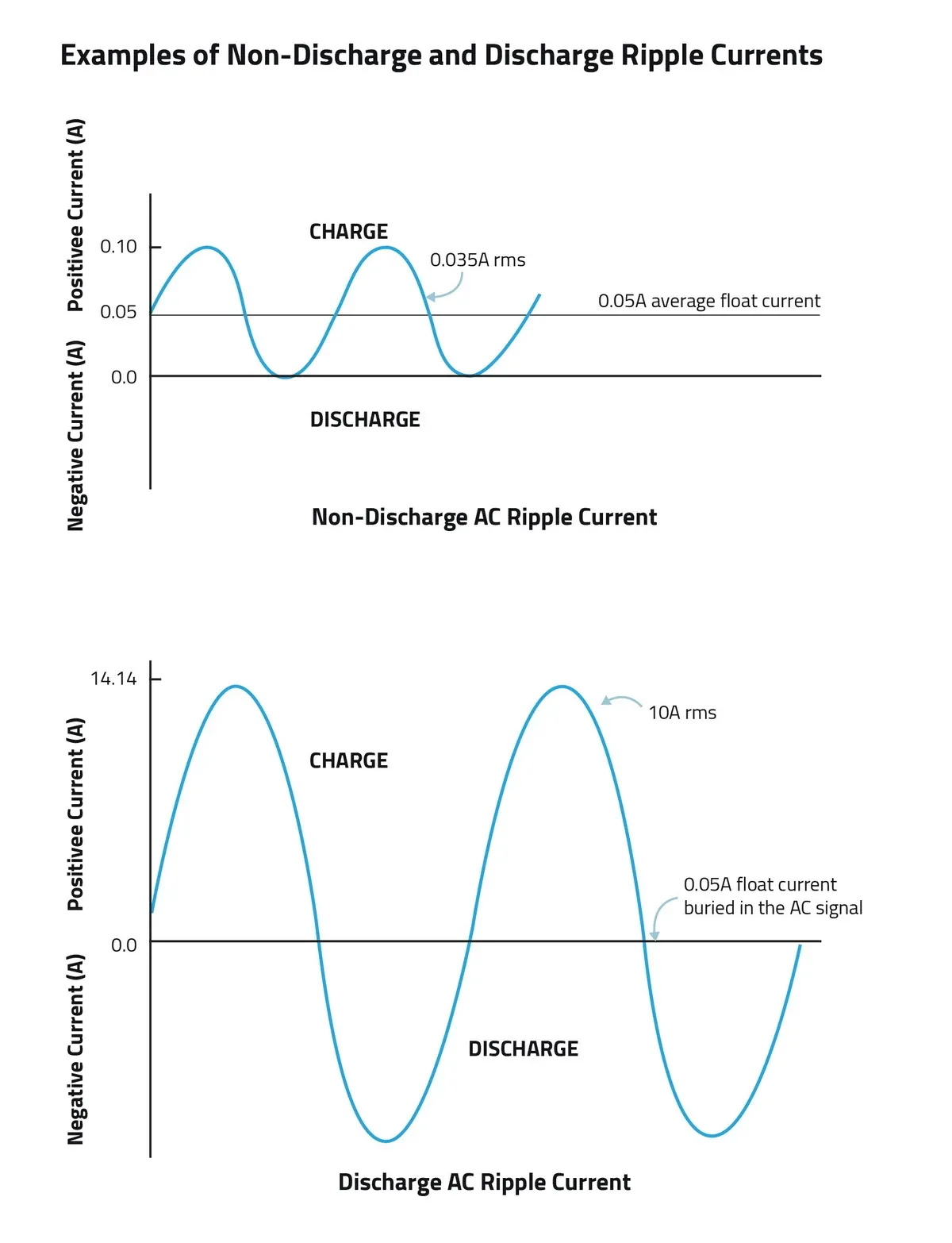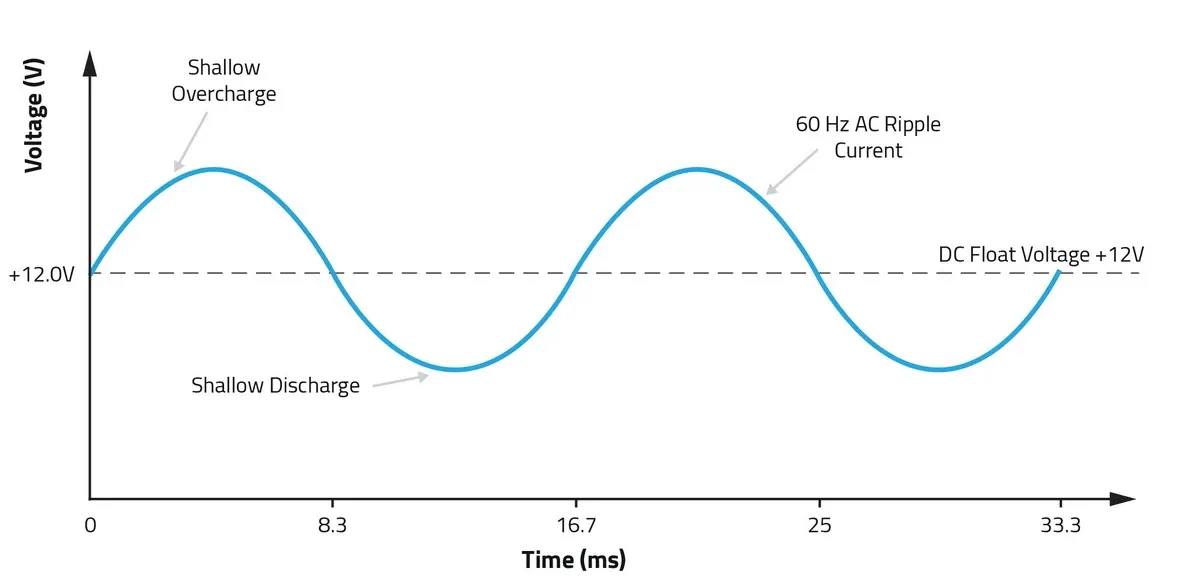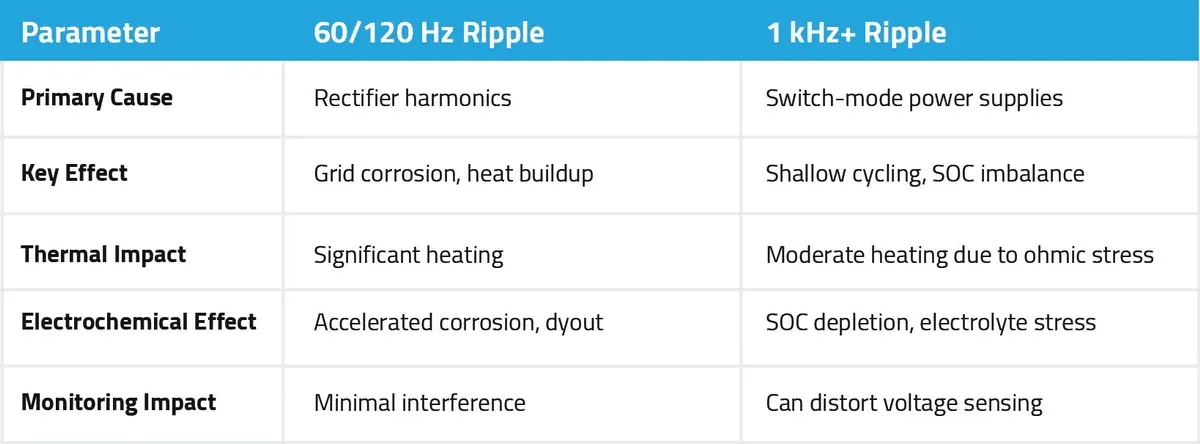The Impact of AC Ripple on VRLA Batteries: Frequency-Dependent Degradation Mechanisms and Monitoring Strategies
Valve-Regulated Lead-Acid (VRLA) batteries remain a critical component in stationary backup power systems such as Uninterruptible Power Supplies (UPS), telecommunications infrastructure, and data centers. Their reliability is paramount, yet a persistent and often underestimated factor influencing their longevity and performance is the presence of AC ripple current. Ripple, the alternating component superimposed on the DC charging voltage and current, is an unavoidable byproduct of rectification and power conversion processes. While low levels of ripple may be tolerable, sustained exposure significantly accelerates battery degradation.
This article explores the influence of AC ripple on VRLA batteries, with particular emphasis on the frequency domains of 60/120 Hz (commonly associated with rectifier harmonics) and 1 kHz+ (high-frequency ripple from modern switch-mode power supplies). Drawing from IEEE standards and peer-reviewed studies, we examine the distinct mechanisms by which ripple at these frequencies affects VRLA battery health.
1. Understanding AC Ripple in Battery Systems
When a VRLA battery is connected to a rectifier or inverter, it is exposed not only to the intended DC float voltage but also to residual AC components. Ripple can be broadly categorized into two types:
- Non-Discharge Ripple – Low-amplitude ripple that never reverses the current direction. It does not directly cycle the battery but causes internal heating and grid corrosion acceleration, which can be detected via thermal monitoring.
- Discharge Ripple – Ripple of sufficient magnitude that periodically reverses current flow, effectively subjecting the battery to high-frequency shallow cycling.
 Figure 1: Examples of Non-Discharge and Discharge Ripple Current
Figure 1: Examples of Non-Discharge and Discharge Ripple Current
Both forms are detrimental, but their severity and impact depend on ripple frequency, amplitude, and duration.
2. IEEE Standards and Ripple Current Recommendations
The IEEE 1188-2005 Recommended Practice for Maintenance, Testing, and Replacement of VRLA Batteries establishes guidelines for ripple exposure. It recommends that:
- The AC component of the charging voltage should not exceed 30 mV rms per cell, and
- Ripple current should remain below 5 A rms per 100 Ah of battery capacity.
These values are based on extensive field data showing premature battery failure when ripple exceeds these thresholds.
Moreover, IEEE notes that ripple-induced heating can cause the negative post temperature to exceed ambient by more than 3 °C, a red flag for accelerated grid corrosion.
Monitoring Note: CellSPY monitors the temperature of every cell/jar at the negative post along with the ambient temperature for precisely this reason.
3. Effects of 60/120 Hz Ripple
The 60 Hz and 120 Hz frequency bands are most commonly introduced by rectifier power supplies connected to AC mains. Their impact on VRLA batteries is primarily tied to electrochemical heating and plate corrosion.
3.1 Grid Corrosion and Gas Evolution
At these low frequencies, ripple causes periodic overcharge and undercharge events within each cycle.
During the positive half-cycle, parasitic reactions such as oxygen recombination and hydrogen evolution dominate, while during the negative half-cycle, shallow discharge reduces the state of charge (SOC).
This repeated cycling accelerates positive plate corrosion, the primary failure mode of VRLA batteries.
 Figure 2: Typical 60 Hz Ripple Current Superimposed on Float Voltage
Figure 2: Typical 60 Hz Ripple Current Superimposed on Float Voltage
(Depiction of a DC float voltage with a sinusoidal AC ripple component showing shallow overcharge and discharge oscillations.)
3.2 Heat Accumulation
Ripple current dissipates energy as I²R heating in the battery’s internal resistance. Studies confirm that ripple-induced heating at 60/120 Hz can raise internal temperatures several degrees above ambient.
Since every 8–10 °C increase in temperature halves VRLA battery life, even modest heating over years of float service significantly reduces service life.
3.3 Accelerated Dryout in VRLA Batteries
VRLA batteries, unlike flooded types, rely on immobilized electrolyte in AGM (Absorbent Glass Mat) or gel structures. Excessive ripple promotes electrolyte dryout due to increased oxygen evolution, which raises internal pressure and water loss through the valves. This phenomenon is especially pronounced under continuous 60/120 Hz ripple.
4. Effects of High-Frequency Ripple (1 kHz+)
With the rise of switch-mode rectifiers and inverters, batteries are increasingly exposed to high-frequency ripple in the kHz range. While this ripple generally has lower amplitude, its high frequency introduces unique challenges for battery maintenance.
4.1 High-Frequency Shallow Cycling
At frequencies above 1 kHz, ripple currents can cause rapid shallow charge-discharge events within the battery. This phenomenon, known as high-frequency shallow cycling, gradually depletes the SOC.
The battery’s float charger compensates by increasing DC float voltage, but the cycle persists, causing long-term degradation.
4.2 Internal Resistance Stress
High-frequency ripple forces charge carriers to move rapidly across the separator, stressing the electrolyte and increasing effective internal resistance. Over time, this raises ohmic losses, further contributing to heating and premature failure.
 Figure 3: High-Frequency Ripple at 1 kHz+
Figure 3: High-Frequency Ripple at 1 kHz+
(Depiction of a float voltage trace with rapid oscillations causing shallow cycling, highlighting the difference from low-frequency ripple.)
5. Comparative Impact: 60/120 Hz vs. 1 kHz+
 Figure 4: Comparative Impact: 60/120 Hz vs. 1 kHz+
Figure 4: Comparative Impact: 60/120 Hz vs. 1 kHz+
In summary, 60/120 Hz ripple primarily drives thermal and chemical degradation, while 1 kHz+ ripple introduces electrical cycling stress. Both frequency domains reduce VRLA lifespan but via distinct mechanisms.
6. Laboratory and Field Evidence
6.1 IEEE INTELEC Studies
Jergl et al. (1996) reported that VRLA batteries in float applications exposed to ripple exhibited significantly shortened lifetimes compared to those on filtered DC. Their findings reinforced the IEEE limits on ripple current.
6.2 Utility and Data Center Observations
Field surveys in data centers confirm that batteries subjected to high ripple currents experience premature failure within 2–4 years, compared to expected 8–10 years under ideal float conditions. Outages attributed to UPS battery failures remain one of the top causes of downtime.
6.3 Ripple-Induced SOC Walk-Down
Recent laboratory experiments suggest that under continuous high-frequency ripple, VRLA batteries tend to stabilize at 60–70% SOC due to the balance of charge and discharge resistances.
This partial state-of-charge operation accelerates sulfation and capacity loss.
7. Mitigation Strategies
7.1 Charger and Rectifier Design
- Use low-ripple rectifiers with advanced filtering stages.
- Ensure ripple voltage remains below IEEE 1188 thresholds.
7.2 Battery Monitoring
- Implement monitoring systems capable of detecting ripple-induced heating and shallow cycling. Monitor the ambient temperature, individual cell/jar temperatures, and analyze how they differ from one another.
- Trigger alarms when negative post temperature exceeds ambient by more than 3 °C.
- Trigger alarms when any 2 cells in the string differ from one another by >3°C.
7.3 Active Charge Balancing
- Employ active equalization to mitigate SOC imbalances aggravated by ripple.
7.4 Preventive Maintenance
- If you aren’t monitoring batteries, conduct periodic impedance testing to detect ripple-induced resistance growth.
- Replace chargers with excessive ripple output.
8. Conclusion
AC ripple is a silent but powerful factor accelerating VRLA battery degradation.
At 60/120 Hz, it induces heat, grid corrosion, and electrolyte dryout, while at 1 kHz+, it introduces high-frequency shallow cycling, SOC walk-down, and monitoring inaccuracies.
IEEE standards provide clear guidelines on acceptable ripple levels, but field evidence shows many systems exceed these thresholds, leading to costly premature failures.
In mission-critical applications where battery reliability defines uptime, operators must prioritize ripple monitoring, advanced rectifier filtering, and active battery management systems.
By mitigating ripple effects, VRLA batteries can achieve their full design life, safeguarding power continuity in critical infrastructures.
References
- IEEE Std 1188-2005, IEEE Recommended Practice for Maintenance, Testing, and Replacement of Valve-Regulated Lead-Acid (VRLA) Batteries for Stationary Applications.
- J. Jergl, B. Cole, and S. Purcell, “Real world effects on VRLA batteries in float applications,” Proc. INTELEC’96 - International Telecommunications Energy Conference, Boston, 1996, pp. 351–357.
- Ruetschi, P., “Aging mechanisms and service life of lead–acid batteries,” Journal of Power Sources, vol. 127, no. 1–2, pp. 33–44, 2004.
- Krein, P., & Balog, R., “Life extension through charge equalization of lead-acid batteries,” Proc. INTELEC 2002, pp. 516–523.


